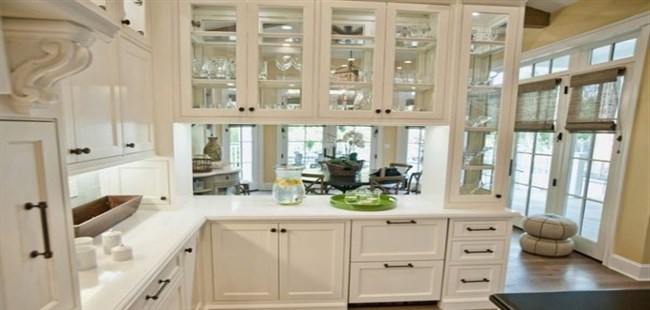If you are planning to update or improve an existing kitchen, there are many inexpensive adjustments to consider. Well, How Can You Make Improvements In The Kitchen?
Change the style of the kitchen by replacing cabinet doors, or improve existing doors with a new paint finish.
Improvements In The Kitchen: Work Surfaces
Counters should be installed at a height that for you. Choose a hard-wearing material that is comfortable to work at. A recommended, heat resistant, does not scratch, chip, or stain standard working height may not be suitable easily, and is easy to maintain and keep clean.
Creating Surfaces
Covering a sink: To create a work surface that you can use if space becomes tight, cut a piece of wood to fit neatly over a sink. When the sink is not in use, put the wood in place.
Making Pan Rests
Using tiles: Make sure that there is always a stable, heatproof surface on which to place hot pans by keeping two sturdy kitchen tiles on the counter next to the stove.
Lighting Work Surfaces
Using spotlights: Choose flexible spotlights so thai you can direct the lighting. Recess them into the ceiling, or place on top of wail cabinets.
• Avoiding glare: Eliminate glare by positioning diffusers over low-level lights.
• Reducing heat: Reduce the heat generated in a kitchen by installing fluorescent lights.
• Locating switches: For flexibility, install separate switches for each area, such as a counter or an eating area.
Planning Ahead
• Positioning counters: Make sure that there is a surface near the entrance on which to place shopping or garden produce when you enter the kitchen.
• Adding insets: Consider having a marble or wooden inset put into a counter for chopping and pastry making. This should extend the whole depth of the counter to avoid creating dirt traps, and the front edge should match that of the counter.
• Avoiding dirt traps: Avoid seams in countertops, since they may trap dirt and become a health risk. Seal unavoidable seams with kitchen sealant.
• Preventing dripping: Look for a counter with a ridged front edge to prevent spilled liquids from dripping over the edge.
Using Dead Space
Storing in corners: Make use of counter space in corners for storing small appliances, such as food processors.
Store sharp knives in a slot cut into the rear part of the counter
Behind a drawer: Check carefully before cutting the slot to make sure that the knives will not block the drawer.
Saving Space
Folding items away: In a small kitchen, install a hinged counter or a table that will fold away while not in use.
Using a rack
To help keep work surfaces clear, hang regularly used, small utensils from a rack between two wall cabinets, within easy reach of the area where you will need them.
Cabinets and Shelves
Here is a wide range of kitchen cabinets to choose from today, and they are available many different styles. Since cabinets last for years, do not be influenced by the latest fashion. If your budget is tight, use plain white cabinets, which are inexpensive and practical.
Keeping Cabinets Clean
• Using plastic coving: To prevent dust and dirt from collecting beneath a floor-mounted cabinet, put coving along the edge of the plinth. Lay flexible flooring, such as vinyl, to cover the coving, and tuck it into the corner where the cabinet meets the plinth.
• Sealing wood: To protect natural wooden cabinets with a hard-wearing, water-repellent finish, coat with polyurethane. Seal hardwood cabinets with oil where appropriate, and reapply the seal frequently.
• Lining interiors: Choose cabinets lined with laminated coatings and drawers lined with heavy-duty plastic, so that you will easily be able to wipe up spills and the sticky residues left by food containers.
Planning Storage
• Adjusting shelves: Choose cabinets with adjustable shelves or racks on runners, so that the heights can be adjusted to suit your needs.
• Using corner space: Install a corner unit with revolving shelves to make use of an otherwise inaccessible corner.
• Disposing of waste: Put a flip- top garbage pail in a cabinet beneath the sink or in the area where most of the food is prepared, so that trash can be disposed of easily.
• Using wall space: Use the space beneath wall cabinets to hang a paper-towel holder or utensil rack. This will help to keep work surfaces clear.
Choosing and Positioning
• Positioning cabinets: If possible, attach a cabinet to a shaded, outside wall if it is to be used for storing food, since this will be cooler than an internal wall. Try to be aware of the temperature inside a cabinet – the cooler the better for food storage.
• Checking stability: Ask a builder to check that a wall is structurally sound enough to take the weight of cabinets before installing wall units. You may find that a partition wall is unable to support the weight.
• Making a partition: Divide kitchen and dining areas in the same room by installing a peninsula. This will provide extra storage space while permitting easy access from one area to another.
• Selecting cabinet doors: Consider installing cabinets that have sliding doors, or doors that slide up and over.
Cabinets
• Making a wine rack: To adapt a floor cabinet for storing bottles of wine, first remove any existing shelves. Then make an X-shaped shelf for the bottles using two pieces of plywood slotted together to fit the cabinet from corner to corner.
• Making a dish drainer: Remove the bottom of a wall- mounted cabinet above the sink, and put a dish rack inside. Wet dishes can then drain into the sink, and you can close the doors to hide it away.
Keeping Shelves Clean
• Covering with a blind: Fit a fireproof roller blind over shelves built into a recess so that dust and grease do not settle on the shelves’ contents.
• Using open shelves: Dust settles easily on open shelves, so use them for items that are used and washed daily.
Choosing cabinets:
• Select units with rounded corners and recessed tiles. Sharp corners and protruding knobs are likely to cause injury.
• Placing wall cabinets: Avoid placing cabinets on a wall above a stove; reaching over a hot burner to gain access to a cabinet is dangerous.
• Siting for height: Position wall cabinets so that the top shelves are easily accessible without necessitating a climb onto1 a chair or stepladder.
Space-Saving Devices
Many home kitchens are quite small, with limited storage space, so creative use of space is essential for the efficient organization of a kitchen. Make use of corners by inserting corner shelves, and hang small items from racks on the wall if you run out of cabinet space.
Saving Cabinet Space
Hanging a rack: Suspend a wooden or metal rack from the kitchen ceiling, and hang pots and pans using butchers’ hooks. Do not hang the rack too low, and check the length of chain needed to bring the pots and pans to an accessible height.
Filling Empty Spaces
Filling gaps: Position a pull-out towel rack in a gap between two cabinets or appliances to keep dish towels tidy and accessible. Alternatively, use gaps between units for storing cookie sheets and trays, freeing cabinet space for other items.
Bright Idea
Using window space If your kitchen window has an unattractive view, or no view at all, put safety glass shelves across the window. Use them for storing attractive glass jars and bottles, plants, or pots of fresh herbs.
Cookbooks and Recipes
Most cooks have a collection of favorite cookbooks, and inevitably these books become well worn. Buy a cookbook stand, or use the tips below to protect your books while cooking. Also, make sure that you keep your favorite recipe clippings in good condition.
Protecting & Storing Cookbooks
• Using a plastic bag: To protect the pages of a cookbook, slip the opened book inside a clear plastic bag to prevent it from being splashed during food preparation.
• Keeping books dry: Attach a narrow wooden shelf with a rim to the wall above a work surface, and use it as a book rest. It will help keep books out of the way of food splashes.
• Storing books: Place a bookshelf on top of a chest of drawers to create a kitchen dresser in which you can keep your cookbooks, display attractive pieces of china, and store kitchen equipment.
Adding an extra shelf
Hang a narrow shelf between a counter and a wall cabinet to create storage space for cookbooks. This will give you quick access to them, and save space on the counter.
Keeping Clippings
• Color-coding recipes: Store different categories of recipe clippings in differently colored photograph albums with peel-back plastic pages. Use blue for fish dishes, for example.
• Using a scrapbook: Paste recipe cuttings into a scrapbook so that you can write notes next to them if necessary.
• Making clever clippings: Store favorite, frequently used recipe clippings in a decorative way by pasting them onto a board or tray to make a collage. Paint over or spray with waterproof varnish so that any splashes of food or grease can be wiped off.






